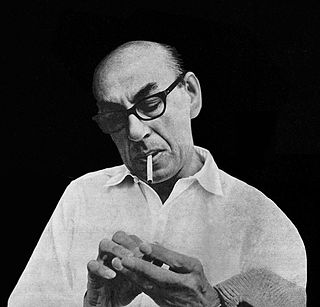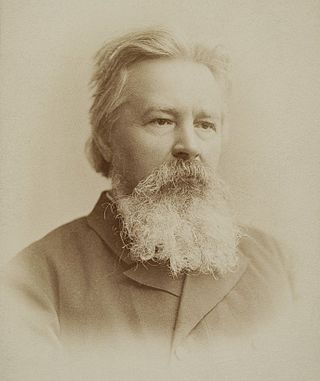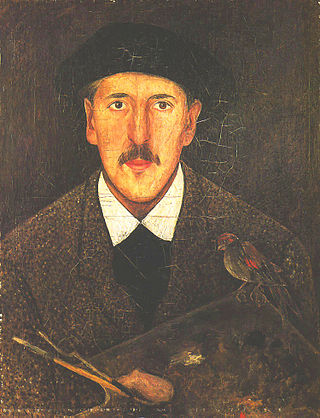
Henryk Pillati (19 January 1832 in Warsaw – 16 April 1894 in Warsaw) was a Polish illustrator, caricaturist and history painter, in the Classical style.

Henryk Pillati (19 January 1832 in Warsaw – 16 April 1894 in Warsaw) was a Polish illustrator, caricaturist and history painter, in the Classical style.
He was born to a wealthy family. In 1845, at age thirteen, he entered the School of Fine Arts in Warsaw. Three years later, both of his parents died during a cholera epidemic. This forced him to leave school and find work to support his surviving younger siblings. [1]
He managed to get by selling small paintings of genre scenes and episodes from the Polish-Swedish wars. From 1852 to 1853, he created a series of large canvases, designed for decorating steamships owned by Count Andrzej Artur Zamoyski, on the Vistula River. The ships were later confiscated by the Russians during the January Uprising. [1]
Later, he received private scholarships that enabled him to spend a year studying at the École des Beaux-Arts in Paris. Four years later, he continued his studies at the Academy of Fine Arts, Munich, then spent some time in Rome. [1]
After 1860, although he continued to paint historical scenes, he was primarily engaged in providing illustrations for books (notably works by Adam Mickiewicz and Józef Ignacy Kraszewski) and several periodicals in Warsaw, including the Tygodnik Illustrowany , Kłosy (Ears), Wędrowiec (The Wanderer) and Biesiada Literacka (Literary Feast). [2]
In 1879, he moved to Saint Petersburg to work for a publishing house, but his increasing alcoholism ruined his health to the point that his younger brother, Ksawery , who was also a painter, had to bring him home, where he spent his final years living in the residence of the Warsaw Charitable Society. His life was later given fictional treatment in the novel Malaria by Wiktor Gomulicki. [2]

Stanisław Witkiewicz was a Polish painter, art theoretician, and amateur architect, known for his creation of "Zakopane Style".

Maurycy Gottlieb(Polish pronunciation ; 21/28 February 1856 – 17 July 1879) was a Polish realist painter of the Romantic period. Considered one of the most talented students of Jan Matejko, Gottllieb died at the age of 23.

Juliusz Fortunat Kossak was an Austrian Polish historical painter and master illustrator who specialized in battle scenes, military portraits and horses. He was the progenitor of an artistic family that spanned four generations, father of painter Wojciech Kossak and grandfather of painter Jerzy Kossak.

Franciszek Kostrzewski was a Polish illustrator, cartoonist, caricaturist, comics artist and painter in the Realistic style.

Henryk Stażewski was a Polish painter, writer, and visual artist. Stażewski's career spanned seven decades and he is considered a pivotal figure in the development of Constructivism and geometric abstraction in Poland. He was one of the few prominent Polish avant-garde artists of the interwar period who had remained active and influential in the second half of the twentieth century.

Henryk Tomaszewski was an award-winning poster artist and the "father" of the Polish Poster School.

Wojciech Gerson was a leading Polish painter of the mid-19th century, and one of the foremost representatives of the Polish school of Realism during the foreign Partitions of Poland. He served as long-time professor of the School of Fine Arts in Warsaw, and taught future luminaries of Polish neo-romanticism including Józef Chełmoński, Leon Wyczółkowski, Władysław Podkowiński, Józef Pankiewicz and Anna Bilińska-Bohdanowiczowa among others. He also wrote art-reviews and published a book of anatomy for the artists. A large number of his paintings were stolen by Nazi Germany in World War II, and never recovered.

Franciszek Ksawery Lampi, also known as Franz Xaver Lampi, was a Polish Romantic painter born in Austria of ethnic Italian background. He was associated with the aristocratic circle of the late Stanisław II Augustus, the last Polish king before the foreign partitions of Poland. Lampi settled in Warsaw around 1815 at the age of 33, and established himself as the leading landscape and portrait artist in Congress Poland soon after Napoleon's defeat in Russia.

Aleksander Kotsis was a Polish painter. He created landscapes, portraits, and genre scenes in a combination Romantic and Realistic style. Most of his paintings are small.

Henryk Hektor Siemiradzki was a Russian-born Polish painter based in Rome, best remembered for his monumental academic art. He was particularly known for his depictions of scenes from the ancient Greek-Roman world and the New Testament, owned by many national galleries of Europe.

Stanisław Masłowski, born Stanisław Stefan Zygmunt Ludgard Masłowski was a Polish painter of realistic style, the author of watercolor landscapes.

Ignacy Aleksander Gierymski was a Polish painter of the late 19th century, the younger brother of Maksymilian Gierymski. He was a representative of Realism as well as an important precursor of Impressionism in Poland.

Tadeusz Makowski was a Polish painter who worked in France and was associated with the School of Paris.

Wojciech Korneli Stattler or Albert Kornel Stattler was a Polish Romantic painter of Swiss aristocratic ancestry, who started training in Vienna and at age 17 went to St. Luke's Academy in Rome. From 1831 he taught as professor at the School of Fine Arts in Kraków. 1850 he returned to Rome. His most famous pupil was Poland's leading painter of historical figures and events, Jan Matejko.

Józef Jan Gosławski was a Polish sculptor and medallic artist. He was a designer of coins, monuments and medals. Laureate of many artistic competitions; decorated with the Silver Cross of Merit.

Władysław Skoczylas was a Polish watercolorist, woodcutter, sculptor and art teacher.

Jan Feliks Piwarski – was a Polish painter, curator, writer and graphic artist; one of the earliest lithographers in Poland.

Ludwik Konarzewski – senior was a Polish painter, sculptor and teacher of fine arts who worked in Upper Silesia and Cieszyn Silesia.

Stanisław Lentz was a Polish painter, portraitist, illustrator, and a professor at the Academy of Fine Arts in Warsaw from 1909.

Antoni Kozakiewicz was a Polish genre painter in the Realist style.